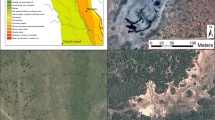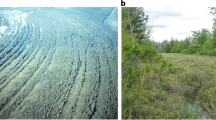Abstract
Hydrologic patterns and soil characteristics were investigated at three high-elevation wetlands in southeastern Kentucky, Martins Fork, Kentenia, and Four Level. Despite below-normal precipitation, water tables at all sites remained within 35 cm of the surface and fluctuated seasonally with peak heights during early spring. Seasonal precipitation contributed substantially to Martins Fork hydrology, while ground water was the primary hydrologic source for Kentenia and Four Level. Vertical hydraulic gradients varied among the sites. Martins Fork was distinguished by strong seasonal downwelling, while Kentenia and Four Level exhibited upwelling and downwelling patterns. All sites exhibited prominent soil hydromorphic features immediately below the surface horizon, moderate organic carbon content (<6.5%), and a pH range between 4.4 and 6.2 according to the buffering capacities of local lithologies. The sites were dominated by sandy loam texture and siliceous mineralogy, reflecting the influence of sandstone parent materials prevalent in the area. Radiocarbon dating established that soil surface layers (≤30 cm) dated less than 250 years B.P., while soil horizons at 100-cm depths varied from 770–1,870 years B.P. Mean C sequestration rates ranged from 0.025 kg C m−2 at Four Level to 0.043 kg C m−2 for Martins Fork and Kentenia, with C accumulation in the upper 100 cm in the range of 19.5–36.7 kg C m−2. Each wetland exhibited distinctive hydrologic and soil properties derived from geologic, geomorphic, and vegetative influences.
Similar content being viewed by others
Literature Cited
Bedford, B. L. and K. S. Godwin. 2003. Fens of the United States: Distribution, characteristics, and scientific connection versus legal isolation. Wetlands 23: 608–29.
Brevik, E. C. and J. A. Homburg. 2004. A 5000 year record of carbon sequestration from a coastal lagoon and wetland complex, southern California, USA. Catena 57: 221–32.
Bullock, P., N. Fedoroff, A. Jongerius, G. Stoops, T. Tursina, and U. Babel. 1985. Handbook for Soil Thin Section Description. Waine Research Publications, Albrighton, UK.
Childress, J. D. 1992. Soil Survey of Bell and Harlan Counties, Kentucky. U. S. Department of Agriculture, Soil Conservation Service.
Cowardin, L. M., V. Carter, F. C. Golet, and E. T. LaRoe. 1979. Classification of Wetlands and Deepwater Habitats of the United States. U. S. Fish and Wildlife Service, Washington, DC, USA. FWS/OBS-79/31.
Csejtey, B., Jr. 1971. Geologic Map of the Bledsoe Quadrangle, Southeastern Kentucky. U. S. Geologic Survey, Washington, DC, USA. Quadrangle Map GQ-889.
Darlington, H. C. 1943. Vegetation and substrate of Cranberry Glades, West Virginia. Botanical Gazette 104: 371–93.
Dean, W. E. and E. Gorham. 1998. Magnitude and significance of carbon burial in lakes, reservoirs, and peatlands. Geology 26: 535–38.
Englund, K. L., H. L. Smith, L. D. Harris, and J. G. Stephens. 1961. Geology of the Ewing Quadrangle, Kentucky and Virginia. U. S. Geologic Survey, Washington, DC, USA. Quadrangle Map GQ-172.
Francl, K. E., W. M. Ford, and S. B. Castleberry. 2004. Characterization of high elevation central Appalachian wetlands. U. S. Forest Service, Northeastern Research Station, Newtown Square, PA, USA. NE-725.
Gibson, J. R. 1982. Alder Run Bog, Tucker County, West Virginia: Its History and Vegetation. p. 101–5. In McDonald, B. R. (ed.) Proceedings of the Symposium on Wetlands of the Unglaciated Appalachian Region. West Virginia University, Morgantown, WV, USA.
Karathanasis, A. D. and B. F. Hajek. 1982. Revised methods for rapid quantitative determination of minerals in soil clays. Soil Science Society of America Journal 46: 419–25.
Mitsch, W. J. and J. G. Gosselink. 2000. Wetlands, third edition. John Wiley & Sons, Inc., New York, NY, USA.
Moore, T. R. and J. Turunen. 2004. Carbon accumulation and storage in mineral subsoil beneath peat. Soil Science Society of America Journal 68: 690–96.
Moorhead, K. K. 2001. Seasonal water table dynamics of a southern Appalachian floodplain and associated fen. Journal of the American Water Resources Association 37: 105–14.
Moorhead, K. K. 2003. Effects of drought on the water-table dynamics of a southern Appalachian mountain floodplain and associated fen. Wetlands 23: 792–99.
Moorhead, K. K., R. E. Moynihan, and S. L. Simpson. 2000. Soil characteristics of four southern Appalachian fens in North Carolina, USA. Wetlands 20: 560–64.
Moorhead, K. K. and I. M. Rossell. 1998. Southern mountain fens. p. 379–403. In Messina, M. G. and W. H. Conner (eds.) Southern Forested Wetlands: Ecology and Management. Lewis Publishers, Boca Raton, FL, USA.
Mowbray, T. and W. H. Schlesinger. 1988. The buffer capacity of organic soils of the Bluff Mountain Fen, North Carolina. Soil Science 146: 73–79.
Murdock, N. A. 1994. Rare and endangered plants and animals of southern Appalachian wetlands. Water, Air and Soil Pollution 77: 385–405.
Pittillo, J. D. 1994. Vegetation of three high elevation southern Appalachian bogs and implications of their vegetational history. Water, Air and Soil Pollution 77: 333–48.
Richardson, J. L., J. L. Arndt, and J. Freeland. 1994. Wetland soils of the prairie potholes. Advances in Agronomy 52: 121–71.
Shafer, D. S. 1986. Flat Laurel Gap, Pisgah Ridge, North Carolina: Late Holocene development of a high-elevation heath bald. Castanea 51: 1–10.
Simard, R. R. 1993. Ammonium acetate-extractable elements. p. 39–42. In M. R. Carter (ed.) Soil Sampling and Methods of Analysis. Lewis Publishers, Boca Raton, FL, USA.
Soil Survey Staff. 2003. Keys to Soil Taxonomy, ninth edition. U. S. Department of Agriculture, Natural Resources Conservation Service, Washington, DC, USA.
Stewart, C. N. and E. T. Nilsen. 1993. Association of edaphic factors and vegetation in several isolated Appalachian peat bogs. Bulletin of the Torrey Botanical Club 120: 128–35.
Stuiver, M. and H. van der Plicht. 1998. INTCAL98 Radiocarbon Age Calibration. Radiocarbon 40: 1041–83.
Tran, S. T. and R. R. Simard. 1993. Mechlich III-extractable elements. p. 43–49. In M. R. Carter (ed.) Soil Sampling and Methods of Analysis. Lewis Publishers, Boca Raton, FL, USA.
U. S. Army Corps of Engineers (USACE). 1987. Wetlands Delineation Manual. Environmental Laboratory, U. S. Army Corps of Engineers Waterways Experiment Station, Vicksburg, MS, USA. Technical Report Y-87-1
U. S. Department of Agriculture, Natural Resources Conservation Service (USDA-NRCS). 1996. Soil Survey Laboratory Methods Manual. Soil Survey Investigations Report No. 42, Version 3.0. National Soil Survey Center, Lincoln, NE, USA.
U. S. Department of Agriculture, Natural Resources Conservation Service (USDA-NRCS). 2006. Field Indicators of Hydric Soils in the United States: A Guide for Identifying and Delineating Hydric Soils, Version 6.0. G. W. Hurt and L. M. Vasilas (eds.) USDA, NRCS, in cooperation with the National Technical Committee for Hydric Soils.
Valett, H. M., S. G. Fisher, N. B. Grimm, and P. Camill. 1994. Vertical hydrologic exchange and stability of a desert stream ecosystem. Ecology 75: 548–60.
Vitt, D. H. 2000. Peatlands: ecosystems dominated by bryophytes. p. 312–43. In Shaw, A. J. and B. Goffinet (eds.) Bryophyte Biology. Cambridge University Press, Cambridge, UK.
Weakley, A. S. and M. P. Schafale. 1994. Non-alluvial wetlands of the southern Blue Ridge — diversity in a threatened ecosystem. Water, Air and Soil Pollution 77: 359–83.
Wieder, R. K. 1985. Peat and water chemistry at Big Run Bog, a peatland in the Appalachian mountains of West Virginia, USA. Biogeochemistry 1: 277–302.
Yavitt, J. B. 1994. Carbon dynamics in Appalachian peatlands of West Virginia and western Maryland. Water, Air and Soil Pollution 77: 271–90.
Zedler, J. B. and S. Kercher. 2005. Wetland resources: status, trends, ecosystem services and restorability. Annual Review of Environmental Resources 30: 39–74.
Author information
Authors and Affiliations
Rights and permissions
About this article
Cite this article
Thompson, Y., Sandefur, B.C., Miller, J.O. et al. Hydrologic and edaphic characteristics of three mountain wetlands in southeastern Kentucky, USA. Wetlands 27, 174–188 (2007). https://doi.org/10.1672/0277-5212(2007)27[174:HAECOT]2.0.CO;2
Received:
Revised:
Accepted:
Issue Date:
DOI: https://doi.org/10.1672/0277-5212(2007)27[174:HAECOT]2.0.CO;2




